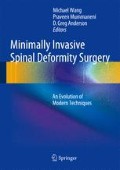Abstract
The goal of spinal arthrodesis is to eliminate pathologic motion between adjacent vertebral segments. Several spinal conditions which are managed and treated operatively after failure of conservative measures require surgical intervention such to achieve a solid fusion. Presently at the time of surgery intervention, spinal instrumentation is often used to further stabilize adjacent levels, but true arthrodesis is independent of the hardware and requires growth of bone across the immobilized spinal segments forming one unified structure. The use of autologous bone grafting has been shown to significantly improve the rate of spinal fusion [1–4]. However, presently, a wide variety of materials are used due to the morbidity of autologous bone graft harvesting either alone or in combination to facilitate fusion; these include autogenous graft, allogenic graft, dematerialized bone matrix, bone morphogenic proteins (BMP), synthetic graft extenders, and synthetic cages. In this chapter we will focus on bone graft extenders.
Access this chapter
Tax calculation will be finalised at checkout
Purchases are for personal use only
References
Young WF, Rosenwasser RH. An early comparative analysis of the use of fibular allograft versus autologous iliac crest graft for interbody fusion after anterior cervical discectomy. Spine. 1993;18:1123–4.
Shapiro S. Banked fibula and the locking anterior cervical plate in anterior cervical fusions following cervical discectomy. J Neurosurg. 1996;84:161–5.
Bishop RC, Moore KA, Hadley MN. Anterior cervical interbody fusion using autogeneic and allogeneic bone graft substrate: a prospective comparative analysis. J Neurosurg. 1996;85:206–10.
An HS, Simpson JM, Glover JM, Stephany J. Comparison between allograft plus demineralized bone matrix versus autograft in anterior cervical fusion. A prospective multicenter study. Spine. 1995;20:2211–6.
Glassman SD, Howard JM, Sweet A, et al. Complications and concerns with osteobiologics for spine fusion in clinical practice. Spine. 2010;35:1621–8.
Abdullah KG, Steinmetz MP, Benzel EC, et al. The state of lumbar fusion extenders. Spine. 2011;36:E1328–34.
Heneghan HM, McCabe JP. Use of autologous bone graft in anterior cervical decompression: morbidity & quality of life analysis. BMC Musculoskelet Disord. 2009;10:158.
Kim DH, Rhim R, Li L, et al. Prospective study of iliac crest bone graft harvest site pain and morbidity. Spine J. 2009;9:886–92.
Silber JS, Anderson DG, Daffner SD, et al. Donor site morbidity after anterior iliac crest bone harvest for single-level anterior cervical discectomy and fusion. Spine. 2003;28:134–9.
Gruskin E, Doll BA, Futrell FW, Schmitz JP, Hollinger JO. Demineralized bone matrix in bone repair: history and use. Adv Drug Deliv Rev. 2012;64(12):1063–77 [Epub ahead of print].
Ray RD, Holloway JA. Preliminary report of an experimental study. J Bone Joint Surg. 1957;39A:1119.
Urist MR. Bone: formation by autoinduction. Science. 1965;150:893–9.
Group MR. US markets for orthopaedic. Biomaterials. 2004(2005).
Groessner-Schreiber B, Krukowski M, Lyons C, Osdoby P. Osteoclast recruitment in response to human bone matrix is age related. Mech Ageing Dev. 1992;62:143–54.
Aaboe M, Pinholt EM, Schou S, Hjorting-Hansen E. Incomplete bone regeneration of rabbit calvarial defects using different membranes. Clin Oral Implants Res. 1998;9:313–20.
Schwartz Z, Somers A, Mellonig JT, Carnes D, Dean D, Cochran D, Boyan B. Ability of demineralized freeze-dried bone allograft to induce new bone formation is dependent on donor age but not gender. J Periodontol. 1998;69:470–8.
Zhang M, Powers Jr RM, Wolfinbarger Jr L. A quantitative assessment of osteoinductivity of human demineralized bone matrix. J Periodontol. 1997;68:1076–84.
Green PJ, Walsh FS, Doherty P. Promiscuity of fibroblast growth factor receptors. Bioessays. 1996;18:639–46.
Böttcher RT, Niehrs C. Fibroblast growth factor signaling during early vertebrate development. Endocr Rev. 2005;26:63–77.
Reddi AH, Reddi A. Bone morphogenetic proteins (BMPs): from morphogens to metabologens. Cytokine Growth Factor Rev. 2009;20:341–2.
Bleuming SA, He XC, Kodach LL, Hardwick JC, Koopman FA, Ten Kate FJ, van Deventer SJ, Hommes DW, Peppelenbosch MP, Offerhaus GJ, Li L, van den Brink GR. Bone morphogenetic protein signaling suppresses tumorigenesis at gastric epithelial transition zones in mice. Cancer Res. 2007;67:8149–55.
Rajaee SS, Bae HW, Kanim LE, et al. Spinal fusion in the United States: analysis of trends from 1998 to 2008. Spine. 2012;37:67–76.
Cammisa Jr FP, Lowery G, Garfin SR, et al. Two-year fusion rate equivalency between grafton DBM gel and autograft in posterolateral spine fusion: a prospective controlled trial employing a side-by-side comparison in the same patient. Spine. 2004;29:660–6.
Schizas C, Triantafyllopoulos D, Kosmopoulos V, et al. Posterolateral lumbar spine fusion using a novel demineralized bone matrix: a controlled case pilot study. Arch Orthop Trauma Surg. 2008;128:621–5.
Delecrin J, Takahashi S, Gouin F, et al. A synthetic porous ceramic as a bone graft substitute in the surgical management of scoliosis: a prospective, randomized study. Spine. 2000;25:563–9.
Lerner T, Bullmann V, Schulte TL, et al. A level-1 pilot study to evaluate of ultraporous beta-tricalcium phosphate as a graft extender in the posterior correction of adolescent idiopathic scoliosis. Eur Spine J. 2009;18:170–9.
Alsaleh KAM, Tougas CA, Roffey DM, Wai EK. Osteoconductive bone graft extenders in posterolateral thoracolumbar spinal fusion: a systematic review. Spine. 2012;37:E993–1000.
Author information
Authors and Affiliations
Corresponding author
Editor information
Editors and Affiliations
Rights and permissions
Copyright information
© 2014 Springer-Verlag Wien
About this chapter
Cite this chapter
Teufack, S., Harrop, J., Prasad, S. (2014). Bone Graft Extenders. In: Wang, M., Lu, Y., Anderson, D., Mummaneni, P. (eds) Minimally Invasive Spinal Deformity Surgery. Springer, Vienna. https://doi.org/10.1007/978-3-7091-1407-0_33
Download citation
DOI: https://doi.org/10.1007/978-3-7091-1407-0_33
Published:
Publisher Name: Springer, Vienna
Print ISBN: 978-3-7091-1406-3
Online ISBN: 978-3-7091-1407-0
eBook Packages: MedicineMedicine (R0)

